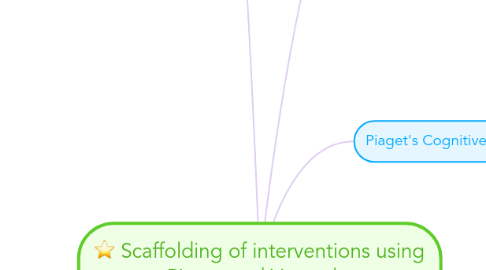
1. 6th grade Interventions: Reading
1.1. Vocabulary
1.1.1. Typical Understanding and application
1.1.1.1. uses grade level vocabulary in generalizes manner
1.1.1.2. Can apply context clues
1.1.1.3. Can apply grammar rules to make words match the tense and pural
1.1.1.3.1. Example: I needed 3 pens. vs. I use 3 pens .
1.1.1.4. Understands simple prefixes and suffixes and generalizes the application to the root words
1.1.2. Atypical Understanding requires Intervention
1.1.2.1. Struggles to identify root words from prefixes or suffixes
1.1.2.2. struggles to read fluently or decode new words
1.1.2.3. not able to drive meaning based on context clues alone
1.1.2.4. Unable to identify when to use grammar rules to change tense or use purals
1.1.3. Interventions
1.1.3.1. 1. Use cooperative learning to explore new words in environment
1.1.3.2. 2. Use hands on material and folder game to build concept of context clues
1.1.3.2.1. Provide direct instruction
1.1.3.2.2. Allow for growth using task analysis to provide scaffoldted instruction and identify where the student deficit is originated from
1.1.3.3. 3. Use lots of examples during instruction that varies in the content and cultural infulence
1.1.3.3.1. Use content that is relevant to the students in your classroom
1.1.3.4. 4. Provide value for learning new skills and using a advance vocabulary
1.1.3.5. 5. Use encouragement and model self talk that students can engage in to complete the assignement
1.2. Reading
1.2.1. Typical understanding and apllication
1.2.1.1. Reads at or above grade level with fluency and demonstrates comprehsnion
1.2.1.2. Identify difference in main idea and supporting detail
1.2.1.3. Identifies key parts to Plot development
1.2.1.4. Uses text features to locate answers
1.2.1.5. Provide textual support for comprehension questions
1.2.2. Atypical Understanding and Development
1.2.2.1. Have little fluency or empathy when reading
1.2.2.2. reads below grade level
1.2.2.3. Unable to provide text evidence or use text feautures
1.2.2.4. Can not follow the stories plot
1.2.3. Interventions
1.2.3.1. 1. Model what reading looks like and provide check list to follow when reading to improve comprehsnion
1.2.3.2. 2. Get parent and sibling involve to increase the cultural value of reading
1.2.3.3. 3. Provide reading instruction at a lower level but on over the same content .
1.2.3.4. 4. Provide reading instruction in small chuck that encourage building confidence not content knowledge 50% of the time
1.2.3.5. 5. Use reading groups or readers theater as a class to provide peer tutoring in shelter environment
1.3. Writing
1.3.1. Typical Understanding and Application
1.3.1.1. uses transitional words to create a flow when writing
1.3.1.2. Relates student experiences to writng
1.3.1.3. developing a voice when writing
1.3.1.4. Spelling and grammar use is correct in 80% of the writing sample
1.3.1.5. can apply all parts of the writing process (pre writing , draft, revise, edit, and publish)
1.3.2. Atypical Understanding and application
1.3.2.1. Wring us unorganized and follows a random squence
1.3.2.2. Grammar and spelling errors distracts from the meaning and comprehension of student writing
1.3.2.3. Unable to apply traditional grammar , spelling and punctuation rules
1.3.2.4. Fails to demonstrate the writing process
1.3.3. Interventions
1.3.3.1. 1. Model effective writing all the time
1.3.3.2. 2. Demonstrate how reading and writing go hand and hand
1.3.3.3. 3. Allow students to write for fun without punishment, in a writing journal where they can reflect and see their progress.
1.3.3.4. 4. Write together as a class to create story to edit and revise.
1.3.3.5. 5. Provide checklist, visual, and lots of feedback to get students to buy in to writing.
2. Put in action
2.1. Goal: Improve student comprehension of homophones
2.1.1. Scaffold the instruction by providing a study sheet in advance to the lesson
2.1.1.1. Include a visual like a Venn Diagram to hat show the relationship between homophones, homonyms, and homographs. Here is a good example: http://theweek.com/article/index/242415/a-handy-guide-to-homophones-homonyms-and-homographs
2.1.1.2. Give the students a whole group lesson
2.1.1.2.1. Then provide differentiated instruction by using cooperation groups, computer, and folder games.
2.1.1.2.2. Give students a hands on assessment like creating a Venn Diagram or playing a game like four corners
2.1.1.2.3. Provide additional instruction using concrete pictures with students who are still struggling
2.1.1.2.4. Introduce homophones in a natural environment and then move to a paper pencil method
3. Vygotsky's Social Culture Development
3.1. Students learn through social interactions and culture.
3.2. Using, " Dialogues" people socially interact and communicate with others to learn the cultural value.
3.2.1. Key Ideas to note:
3.2.1.1. Zone of Proximal- "Where learning takes place"
3.2.1.2. Private Speech- "Self talk"
3.2.1.3. Cooperative learning- "Peer Tutoring or teaching"
3.2.1.4. Scaffolding-" Adult assisted leaning"
3.3. A teacher utilizing this method would be very active by scaffolding, offering assistance, and helping facilitate cooperative learning groups.
4. Piaget's Cognitive Development
4.1. Follows Universal and Consecutive Stage * Note not all people will reach t the final stage
4.1.1. Sensorimotor: Birth to age 2
4.1.1.1. Uses reflexes to interact with world
4.1.1.2. can reverse actions but can not reverse thinking
4.1.2. Peroperational: ages 2 to 7 years
4.1.2.1. Egocentric
4.1.2.2. Collective monologues with others( each person may be talking but they are not interaction)
4.1.3. Concrete Operational: ages 7 to 11 years
4.1.3.1. Learn best through hands on methods
4.1.3.2. learns: basic reasoning skills, compensation, and reversibility
4.1.4. Formal Operational: ages 11 yeas plus
4.1.4.1. think abstractly by using inductive and deductive reasoning
